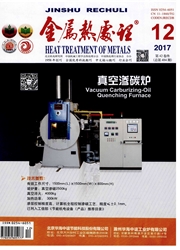

 中文摘要:
中文摘要:
为了探讨脉冲电流参量对AZ31B镁合金微弧氧化过程的影响规律,利用涡流测厚仪测量陶瓷层厚度,采用扫描电镜观察陶瓷层表面形貌,根据电压变化曲线计算微弧氧化过程能量消耗。结果表明,随脉冲频率由500 Hz增至2000 Hz,镁合金微弧等离子体诱发时间由87 s减小至12 s,微弧等离子体诱发电压先降低后趋于稳定并在脉冲频率为1500 Hz时达到最低值177 V;陶瓷层表面放电微孔直径变大,数量减少,陶瓷层厚度增大同时膜层致密性变差;镁合金微弧等离子体诱发过程的能量消耗随脉冲频率增大先降低后升高,并在脉冲频率1500 Hz时达到最小值2.2 kJ;陶瓷层生长过程能量消耗随脉冲频率增大呈线性增加,生长单位厚度陶瓷层的能量消耗也增多,脉冲频率500 Hz时达到最小值22.3 kJ/μm。
 英文摘要:
英文摘要:
Effect of current pulse parameter on micro-arc oxidation( MAO) process for AZ31 B magnesium alloys was investigated. The thickness of MAO coating was measured by eddy current thickness gauge. The surface morphologies of MAO coating were observed by scanning electron microscope( SEM). The energy consumption of MAO process was calculated by curves of voltage-time. The results indicate that with the current pulse frequency increasing from 500 to 2000 Hz,the arcing time during MAO process shortens from 87 s to 12 s,the arcing voltage first drops and then increases. When the impulse frequency is 1500 Hz,the arcing voltage reaches the minimum value of177 V. The pore diameter of millipore is enlarged but the quantity is reduced. And the thicker ceramic coating is obtained on the AZ31 B magnesium alloy samples but density of MAO coating decreases. The energy consumption of arcing process is decreased at first then raised with the increase of pulse frequency,and the minimum value is 2. 2 kJ when the pulse frequency is 1500 Hz. The energy consumption of MAO coating growing process is linearly increased with the increase of pulse frequency. The energy consumption per unit thickness of MAO coating is raised stability,and the minimum value is 22. 3 kJ/μm when pulse frequency is 500 Hz.
 同期刊论文项目
同期刊论文项目
 同项目期刊论文
同项目期刊论文
 期刊信息
期刊信息
